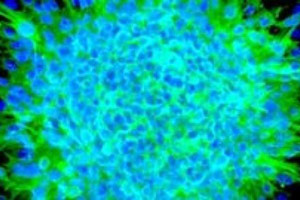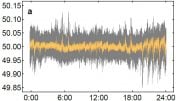
Stem cells under a microscope. Credit: King’s College London
A newly published study shows for the first time that if cardiac stem cells are eliminated, the heart is unable to repair itself after damage.
Researchers at King’s College London have for the first time highlighted the natural regenerative capacity of a group of stem cells that reside in the heart. This new study shows that these cells are responsible for repairing and regenerating muscle tissue damaged by a heart attack which leads to heart failure.
The study, published in the journal Cell, shows that if the stem cells are eliminated, the heart is unable to repair after damage. If the cardiac stem cells are replaced the heart repairs itself, leading to complete cellular, anatomical, and functional heart recovery, with the heart returning to normal and pumping at a regular rate.
Also, if the cardiac stem cells are removed and re-injected, they naturally ‘home’ to and repair the damaged heart, a discovery that could lead to less-invasive treatments and even early prevention of heart failure in the future.
The study, funded by the European Commission Seventh Framework Program (FP7), set out to establish the role of cardiac stem cells (eCSCs) by first removing the cells from the hearts of rodents with heart failure. This stopped regeneration and recovery of the heart, demonstrating the intrinsic regenerative capacity of these cells for repairing the heart in response to heart failure.
Heart failure – when the heart is unable to pump blood around the body adequately – affects more than 750,000 people in the UK, causing breathlessness and impeding daily activities. Current treatments are aimed at treating the underlying causes, such as coronary heart disease, heart attack, and blood pressure through lifestyle changes, medicines, and in severe cases, surgery. These treatments are sometimes successful in preventing or delaying heart failure. However, once heart failure develops the only curative treatment is heart transplantation.
By revealing this robust homing mechanism, which causes cardiac stem cells to home to and repair the heart’s damaged muscle, the findings could lead to less invasive treatments or even preventative measures aimed at maintaining or increasing the activity of the heart’s own cardiac stem cells.
Dr Georgina Ellison, the first author of the paper, and Professor Bernardo Nadal-Ginard, the study’s corresponding author, both from the Center of Human & Aerospace Physiological Sciences and the Center for Stem Cells and Regenerative Medicine at King’s, said: ‘In a healthy heart the quantity of cardiac stem cells is sufficient to repair muscle tissue in the heart. However, in damaged hearts, many of these cells cannot multiply or produce new muscle tissue. In these cases, it could be possible to replace the damaged cardiac stem cells or add new ones by growing them in the laboratory and administering them intravenously.’
Dr Ellison added: ‘Understanding the role and potential of cardiac stem cells could pave the way for a variety of new ways to prevent and treat heart failure. These new approaches involve maintaining or increasing the activity of cardiac stem cells so that muscle tissue in the heart can be renewed with new heart cells, replacing old cells or those damaged by wear and tear.
‘The cardiac stem cells naturally home to the heart because the heart is their home – they know to go there. Current practices involve major operations such as injection through the heart’s muscle wall (intramyocardial) or coronary vessels (intracoronary). The homing mechanism shown by our research could lead to a less invasive treatment whereby cardiac stem cells are injected through a vein in the skin (intravenously).’
Professor Nadal-Ginard added: ‘Although an early study, our findings are very promising. Next steps include clinical trials, due to start in early 2014, aimed at assessing the effectiveness of cardiac stem cells for preventing and treating heart failure in humans.’
Reference: “Adult c-kitpos Cardiac Stem Cells Are Necessary and Sufficient for Functional Cardiac Regeneration and Repair” by Georgina M. Ellison, Carla Vicinanza, Andrew J. Smith, Iolanda Aquila, Angelo Leone, Cheryl D. Waring, Beverley J. Henning, Giuliano Giuseppe Stirparo, Roberto Papait, Marzia Scarfò, Valter Agosti, Giuseppe Viglietto, Gianluigi Condorelli, Ciro Indolfi, Sergio Ottolenghi, Daniele Torella and Bernardo Nadal-Ginard, 15 August 2013, Cell.
DOI: 10.1016/j.cell.2013.07.039









i am wondering if the stem cells we are seeking already exist and are doing exactly what we want them to; repair the damage. If we are ‘finding’ them then they are already doing their job and have been all along.
Whatever happened to the research demonstrating that heart stem cells were produced in reaction to small doses of Diclofenac? I had moderate HF with declining ventricular output and worsening symptoms for several years – totally reversed after several small applications of Diclofenac Sodium Topical Gel over a few months. Have now been symptom free for going on 4 years. Haven’t been able to find any new info since the original rat studies were published – about 5 or 6 years ago.